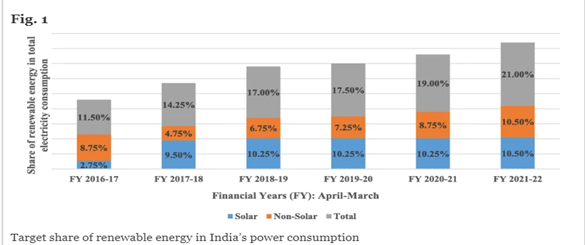

7th June 2023 (8 Topics)
Context
In the upcoming G20 forum, India is planning to propose a multiple energy pathways approach to accommodate the diverse contexts and development trajectories of countries, for which States of India, plays a very important role.
About
- As India’s climate and energy targets are both at a confluence, it is important to look at the trajectory of growth and development.
- States are critical actors in India’s energy transition as there is a multi-tier governance of energy production and usage.
- An effective transition will require bridging the ambitions and implementation gaps between the Centre and the States.
- Simultaneously, national ambitions need to factor the varying incentive structures, processes, and institutional capacities at the State level.
Present scenario:
- As of today only Gujarat, Karnataka, and Rajasthan met their individual targets in terms of achieving sustainable energy.
- Moreover, about 80% of the current renewable energy capacity is confined to six states in the west and south of India.
- According to the International Renewable Energy Agency (IRENA), a quarter of India’s energy demand can be met with renewable energy.
- The country could potentially increase its share of renewable power generation to over one-third by 2030.

Estimated energy potential in India:
- For 2006, the renewable potential was estimated as 85,000 MW with wind 4500 MW, solar 35 MW, biomass/bioenergy 25,000 MW, and small hydropower of 15,000 MW.
- For Solar energy: India is a tropical country and receives significant radiation, and hence the solar potential is very high.
|
According to the annual report of the Ministry of New and Renewable Energy (MNRE) for 2017–2018, the estimated potential of wind power was 302.251 GW (at 100-m mast height), of small hydropower 19.749 GW, biomass power 17.536 GW, bagasse cogeneration 5 GW, waste to energy (WTE) 2.554 GW, and solar 748.990 GW. |
Why do states matter?
- States are important entry points to engage with policy visions, plans and actions.
- States as spheres of implementation are critical to the realisation of national targets.
- The legacy issues in the electricity sector, such as high losses, unreliable supply and service quality, if left addressed, could be exacerbated by the transition.
- States as laboratories of policy innovations have been instrumental to India’s energy transition.
- States could also be roadblocks to national goals, particularly when the goals are perceived to be misaligned with State priorities.
- For example: PM KUSUM is an adoption of successful State experiments on the solarisation of agriculture at a national scale.
Way forward:
- Centre must mandate to update the State Action Plans on Climate Change, recommendations to set up State-level steering committees for energy transitions, and regular meetings of the Central and state energy ministers reinforce the importance of States.
- Central agencies have also developed multiple indexes that rank States on different aspects of energy transition.
- There is a need to complement analysis of State-level preparedness for energy transition.
More Articles


